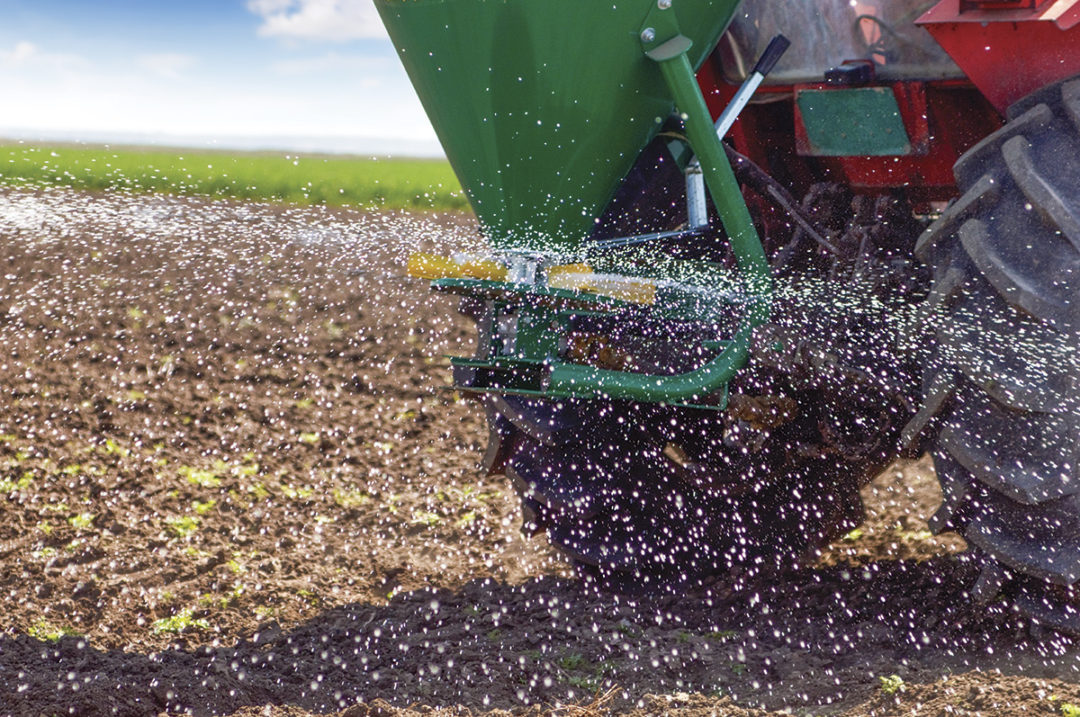There is nothing more beautiful (to your eye, yield monitor and bottom line) than a perfectly and uniformly fertilized field. Broadcast fertilizer spreaders are used to apply the bulk of most dry fertility programs – making them an important factor in crop productivity and return on your fertilizer investment. Just like all pieces of equipment on the farm, proper setup and calibration are critical.
“We’ve all seen fields that are almost wavy across the field. That's because the fertilizer spread pattern is uneven,” says Daryl Patten, operations manager at Heartland Ag Systems, an application equipment dealer and manufacturer headquartered in Hutchinson, Minnesota. “The operator may have put the right total amount on the field, but because of improper settings, poor maintenance, operator error or worn equipment, different rates were applied within the field.”
For farmers, this streaking comes with the potential for an embarrassing ribbing at the coffee shop. Most importantly, it can significantly affect crop yields.
Published studies in small grains have shown when nitrogen application rates vary from 20% up to 40% across the swath, the resulting yield variations compared to the correct rate are 17 to 45 bushels per acre.
Uneven application can be a nemesis for farmer applicators and is especially noticeable when the rate of nutrients, such as nitrogen, varies in the overlap areas. When the cover crop seed is uneven, in turn, there will be varied emergence and noticeable, uneven stand density. Though this happens rarely when product is spread by professional applicators, thanks to the continually advancing spinner technology introduced by industry-leading manufacturers more than 20 years ago, the application experts at Heartland offer these tips for farmers who own their own machines.
Prep your spreader for an even spread pattern
The best way to ensure optimal performance is to routinely pattern test the fertilizer spreader with the product(s) or blends that will be spread, conducting a pan test in real-world conditions.
Patten recommends completing these important steps before you pan test.
1. Check the hitch height for pull-type spreaders. If the spreader is hitched to the tractor too low or too high, the angle of the spinners to the field surface will affect the distance fertilizer particles are thrown. Turn to the operator’s manual for the right height. For truck-mounted spreaders, level the spinners with respect to the rest of the machine.
2. Run the spreader at its intended operating speed (ground speed). Be sure you can maintain this speed over the field’s terrain.
3. Make sure your spreader is in good condition and well maintained:
- Check for worn or corroded parts, rusted and sagging spinner frames, loose components and sticking bearings that can cause the machine to work poorly.
- Replace worn and bent spinner discs and/or blades.
- Remove buildup of fertilizer and lime on spinner discs and/or blades.
- Free any frozen mechanisms.
- Replace corroded and rusty hoppers and components.
- Consult the owner’s manual for guidance on correcting anything that may be out of adjustment.
4. Check the spinner disc speed. For machines with dual spinners, using a handheld tachometer, be sure the fins on the spinner discs are rotating at the same speed to prevent varied patterns on the left versus the right side of the swath. On machines with an operator interface, ensure the rpm of the spinners matches the rate controller setting.
“Today’s technology advancements, like electronic and hydraulic dual spinner speed monitoring and control on the commercial spreaders used by ag retailers, allow the operator to watch and manage spinner speed from within the cab and receive warnings if the spinners aren’t operating properly,” Patten explains. “That’s just one example of how manufacturers are helping ag retailers deliver the right nutrient, in the right place, at the right rate, at the right time in the growing season.”
5. Check the density and quality of fertilizer to be spread. Fertilizer that has been handled several times, especially through augers, may have lots of fine particles and dust.
“Changes in product (season to season, location to location, load to load) have an impact on a machine’s performance and the quality of the application pattern. One setting does not ‘fit all,’” says Patten. “Dust and fine particles can change the flow of product through the spreader, affecting the accuracy of the application since fine particles often aren’t thrown as far as larger particles.”
Pan test to ensure an even spread pattern
Patten reiterates, “Spinner spreaders are a great tool – easy to use, accurate and with proper maintenance – and the most cost-effective form of application for farmers who own their own machine. At the farm level, the best way to ensure your machine is working properly is to routinely pattern test in actual field conditions with the product(s) or blends that will be spread.” Though it is tempting to evaluate spread pattern uniformity in the field by looking at the fertilizer on the soil surface, this isn’t recommended. Crop residue, soil surface cracks, soil color and clods can make it hard to see and compare product distribution.
Evaluating a spread pattern involves using a calibration kit that includes pans with baffles, which are laid out across the path of the spreader. Baffles are important to keep fertilizer granules from bouncing out. Once pans are in place, a pass is made over the pans to spread fertilizer at the required speed and proper machine settings. Samples are caught across the width of the swath and compared. Calibration kits can be bought from many application equipment suppliers and may also be available through some fertilizer retailers.
Each time a different product is spread, or the rate of application changes, the spread pattern should be checked and the necessary adjustments made.










